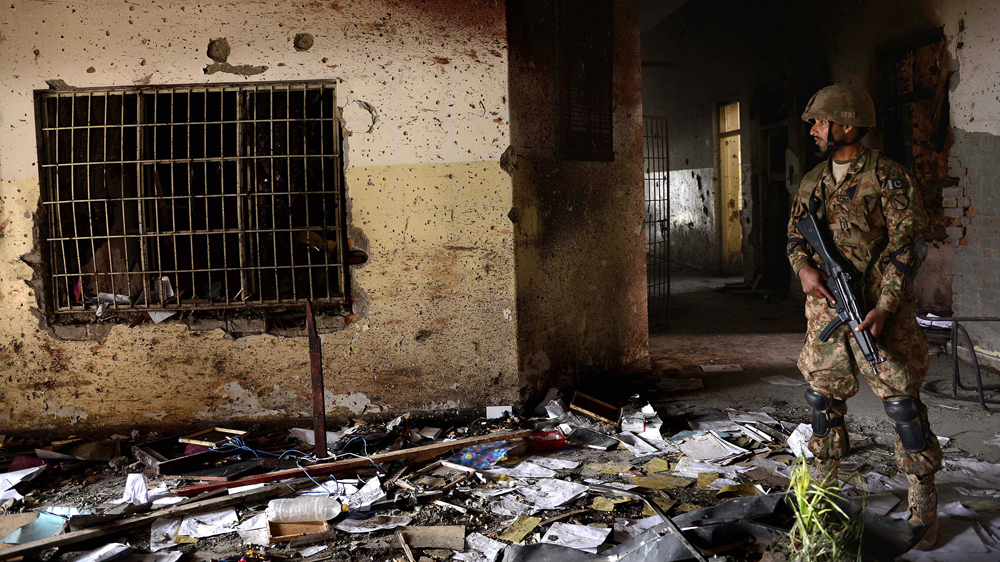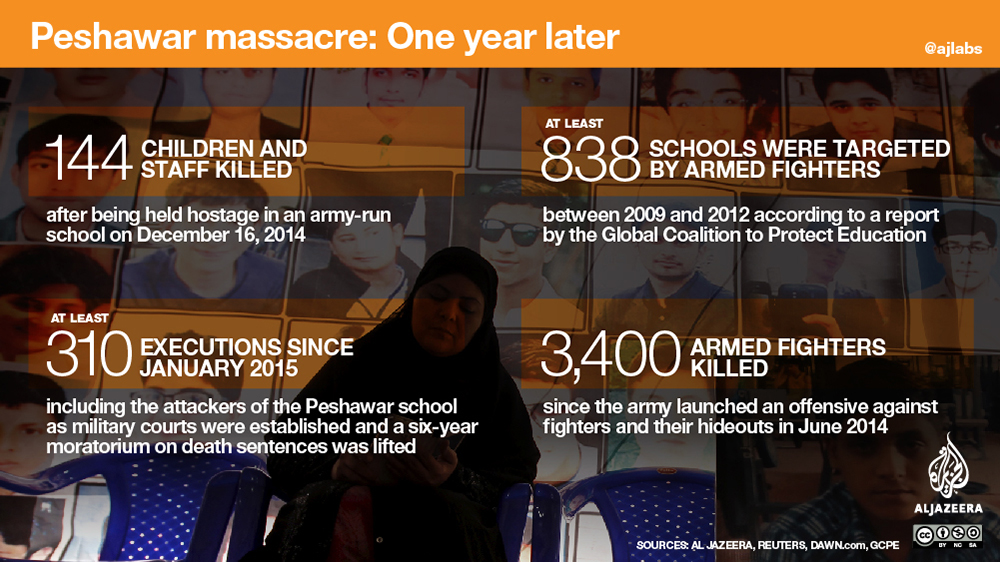Remembering the Peshawar school massacre
Teachers remember the day when armed men attacked a school in Peshawar, killing 144 people.

Peshawar, Pakistan – Chemistry teacher Andaleeb Aftab had spent the morning invigilating at an exam before taking a break in the school’s staff room. It was just as she was beginning to make her way back to the classroom that she heard the screams.
There were gunmen in the school, a colleague was shouting.
Keep reading
list of 4 itemsAustralian war crimes whistleblower David McBride jailed for six years
Will Israel’s war on Gaza sway South Africa’s election?
Masked Tunisian police arrest prominent lawyer for media comments
“Our clerk, Shaheed Shafik, who is no more now, shouted and told me to go back,” Andaleeb remembers.
She ran back into the staff room and stayed there with three other members of staff. They could hear the shooting and shouting outside.
When Andaleeb opened the door a few minutes later, she saw a gunman in the corridor.
“He was outside, just 10 yards from us, and he fired. We stepped back inside and bolted the door. He did not say anything but just fired. We had no way out so we went into the bathroom.”
Andaleeb is talking from her home in Peshawar, a sprawling dusty metropolis in the northwest province of Khyber Pakhtunkhwa, bordering Afghanistan, where everyone seems to have been affected by violence.
She calmly recalls the events of December 16, 2014. That was the day when about seven armed fighters from the Pakistan Taliban (TTP) entered the Army Public School where she taught and slaughtered 144 people, mostly children between the ages of 12 and 16. Many of the pupils were shot as they hid under desks in their classrooms or crouched behind chairs in the school’s auditorium. Some were told to pray before they were shot. One of the members of staff was reportedly burned alive in front of the children.
READ MORE: Peshawar School massacre – the Aftermath
As that horror unfolded, Andaleeb and her three colleagues barricaded themselves in the staff room toilet. For nearly eight hours they stayed there, listening to the sounds of gunmen systematically murdering the teenage schoolchildren, many of whom they had taught.
“The terrorists shouted at the boys to say a kalma [Islamic prayer] before they shot them,” says Andaleeb.
When she was eventually rescued by members of the military eight hours later, her first thought was to ask after her own three children, who were all pupils at the school. Ten-year-old Maaz and 13-year-old Farwa were unharmed. But her oldest child, 16-year-old Huzaifa, had been killed. He had been shot five times.
She remembers going to see Huzaifa’s body at the nearby Combined Military Hospital, where many of the victims had been laid out for family members to identify them.
“I thought, ‘How will my boy be?’,” she says. “But he was just smiling … you would not believe it but he was smiling.”
The terrorists shouted at the boys to say a kalma (Islamic prayer) before they shot them.
The TTP released a video claiming responsibility for the attack and warning of more to come. “Our men attacked the school and killed children of army personnel – not civilians. They asked about their identity before killing them. These people will always be our target and we will kill them in the streets, markets, everywhere,” said the TTP’s leader, Maulana Fazlullah.
According to the South Asia Terrorism Portal, more than 20,000 civilians have been killed in attacks by armed groups in Pakistan between 2003 and 2015.
And the December 16 attack on the school in Peshawar wasn’t the first to target schoolchildren. According to a report last year from the Global Coalition to Protect Education from Attack, at least 838 schools in Pakistan were targeted between 2009 and 2012.
Three kisses
But the massacre at the Army Public School was by far the deadliest attack by an armed group in the country’s history and it sent shockwaves through Pakistan and beyond.
Schools in Khyber Pakhtunkhwa were closed for nearly a month and, when they reopened, some anxious parents debated whether or not to send their children back.
“These kids are traumatised and afraid this could happen again,” says Tahir Aneez Malik, who lost his 14-year-old-son, Hammad, in the massacre.
Hammad was shot twice, Tahir explains. “They [the killers] are animals, wild animals. They are the enemies of this country. They call themselves Muslims but they kill innocent people,” he says.

Weeping, Tahir’s wife, Irum, remembers how Hammad blew her three kisses before he left for school that morning. That was the last time she ever saw him.
“He was very caring. If I ever gave him chocolate he would keep the wrappers and never throw them away. He would say, ‘Mum, this has been touched by you, so I will keep it’,” she says.
As the grieving parents speak, their daughter, Kashaf, sits quietly beside her mother. “I miss my brother,” the 12-year-old says. She survived the attack and is now back at the same school, where security has since been increased.
In an attempt to allay people’s fears, the local authorities called for the introduction of new safety measures including security gates, walls topped with razor wire and CCTV cameras. More controversially, the local government said it would train teachers to carry weapons. While some teachers have said the move has allowed them a measure of security within the classroom, others have argued that a teacher’s job should just be to educate.
Missing friends
Meanwhile, those who were there that day continue trying to make sense of it. Among them is 27-year-old maths teacher Mahrukh Qayyum, who was teaching a class of grade-5 pupils when the attack happened.
When she heard gunfire, she initially assumed that it was a regular army drill being conducted by the soldiers who were stationed at the school. She only realised that it was something much more sinister when school administrators burst into her classroom to tell her that there were armed men on the roof.
READ MORE: ‘I witnessed the Peshawar massacre’
“They told us to lock the doors of the classroom, so we did, and we lay down on the floor of the class with the children for around two hours,” she remembers. “We heard a lot of firing, very loud firing, which went on continuously. We were terrified as we had never faced a situation like that.”
Many of her students cried; others, she said, fainted.
But they only discovered the full extent of what had taken place after they were rescued and returned home.
“I watched it on television and I just could not believe how many people died. I still can’t,” she says.
Mahrukh had taught several of the murdered pupils when they were in the 4th and 5th grades. She quietly lists their names: “Asad Aziz, Muhammad Uzair, Gulsher, Yaseen, Mujahid, Ammar Malik, Mujjtaba.” She taught them for two years and knows their parents, she adds.
READ MORE: Pakistan mourns school massacre dead
“I also knew teachers and staff who were killed – Hafsa Khushk, Beenish Pervez, Salma Tariq, Professor Nawab Ali, Sajjad Ali, Mudassir Khan, Professor Saeed and Professor Tahira Qazi.”
Mahrukh was badly shaken by the ordeal but has been able to return to teaching with the support of friends and family and in the knowledge that security at the school has been heightened.
“We went back to school on Monday, January 12. I was feeling OK. My morale was high because my students were there, so we were feeling all right. Education is important so we cannot sit at home,” she says.
Her sentiments are shared by Andaleeb Aftab, who is also back teaching at the school. “On the first day the atmosphere was difficult for the kids and parents,” she says. “People were crying … the kids were missing their friends and we were missing staff …150 companions were lost that day and we don’t want that day to come again.”
But some parents have been too afraid to let their children return, Andaleeb says, even though the school has offered counselling.
She says her faith has helped her to cope with the loss of her son and that she is grateful for the 16 years of his life.
She urges other parents to have the courage to send their children back to school, even though they are afraid.
“I am back teaching in the same classroom where my son sat. His name is still on notice boards and things he made are still on the walls. If I can gain the courage then why not someone else?”
And what of the men who did this?
“I am leaving them to face the justice God has for them,” Andaleeb says quietly.
